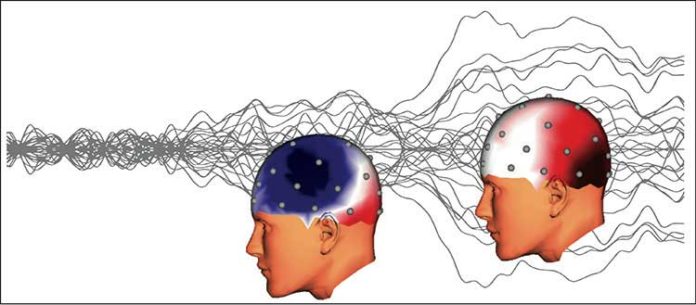A major role of sensory receptors is to help us learn about the environment around us, or about the state of our internal environment. But what happens within the brain when it perceives a threatening signal, for example- an aggressive voice? How does our brain distinguish this voice from surrounding noise?
Scientists at the University of Geneva, have found the answer to these questions. They have studied brain activity during the processing of various emotional voices.
Scientists were keen to know how fast our attention responds to the different intonations of the voices.
They found that we notice a voice much faster when it is considered threatening than when it is perceived as normal or happy. Our attention is more focused on threatening voices to enable us to clearly recognize the location of the potential threat.
Scientists involved 35 participants in the study. To examine the brain’s response to threats in the auditory environment, scientists presented 22 different voices of humans. All those sounds were neutral utterances or expressed either anger or joy. By using two loudspeakers, scientists presented these sounds to the participants.
They then used electroencephalogram (EEG) to measure electrical activity in the brain down to the millisecond. While tracking, they mainly focused on the electrophysiological components related to auditory attentional processing.
Leonardo Ceravolo, a researcher at UNIGE’s Swiss Centre for Affective Sciences said, “Each participant heard two sounds simultaneously: two neutral voices, one neutral and one angry voice, or one neutral and one happy voice. When they perceived anger or joy, they had to respond by pressing a key on a keyboard as accurately and quickly as possible. We then measured the intensity of brain activity when attention is focused on the different sounds, as well as the duration of this focus before a return to the basic state.”
Later on, scientists used data from the EEG to examine the appearance of a cerebral marker of auditory attention called N2ac.
Nicolas Burra said, “When the brain perceives an emotional target sound, N2ac activity is triggered after 200 milliseconds. However, when it perceives anger, the N2ac is amplified and lasts longer, which is not the case for joy!”
Ceravolo said, “Subsequently, after 400 milliseconds, our attention must disengage from the emotional vocal stimulus. At this moment, a cerebral marker of auditory attention, called LPCpc, intervenes. Interestingly enough, LPCpc activity is also stronger for angry than for happy voices.”
“This happens because, Anger can signal a potential threat, which is why the brain analyzes these kinds of stimuli for a longer time. In an auditory environment, this mechanism allows us to not become alarmed at the slightest potentially threatening noise or, conversely, to adopt the most appropriate behavior in case of danger. These extra milliseconds of attention are, therefore, crucial to the accurate interpretation of a threat in a complex auditory environment.”
Nicolas Burra said, “This additional temporal cost was also evident in the participants’ response times. When they had to indicate that they perceived anger, it took them longer than when they did so for joy. In contrast, brain activity was enhanced in the case of angry stimuli. Does it sound conflicting?”
“No. The explanation is logical. As attention in the brain remains focused on the threatening sound, the motor response via the keyboard is delayed.”
This is for the first time, scientists have demonstrated that in a few hundred milliseconds, our brain is sensitive to the presence of angry voices. This rapid detection of the source of a potential threat in a complex environment is essential, as it is critical in crisis situations and a great advantage for our survival.
The study is published in the journal Social, Cognitive and Affective Neuroscience.
